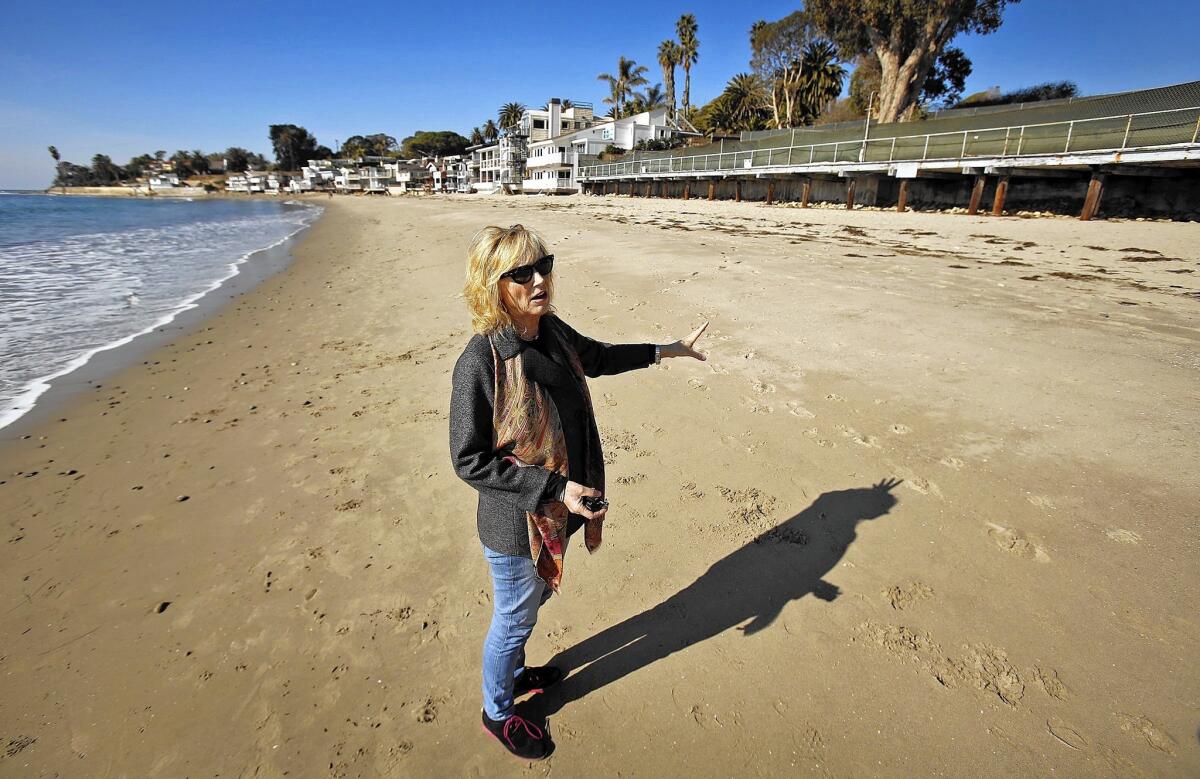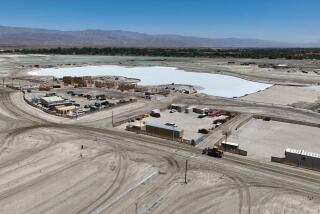Montecito poised to decide on a modern version of Miramar Hotel

When Michael Chenoweth was growing up in Pasadena, his parents would load him and his four younger siblings into the car and head north on Highway 101 to spend long weekends at the Miramar Hotel.
The kids would frolic in the surf, tease the sharp-eyed French lifeguard named Jacques and swim out to the floating deck bobbing in the sea. At night, they would gather for dinner at the beachfront restaurant and on the Fourth of July watch fireworks scatter glitter across the dark sky.
Time spent at the Miramar was magical for Chenoweth, now 45 and with children of his own, as they were for generations of Californians whose families traveled annually to the storied hotel and its blue-roof bungalows in this exclusive enclave between the Santa Ynez Mountains and the Pacific.
“There was nothing else like it around,” said Chenoweth, a commercial real estate broker in Santa Barbara who still surfs regularly off Miramar Beach. “The Miramar was a big part of the community. It was really fun staying there.”
But over time, the hotel slid into disrepair and was closed nearly 15 years ago. It passed through the hands of owners whose plans to revive it were stymied by recessions, financial setbacks, NIMBYism and an approval process that seemed to move more slowly than the snails crawling through the Miramar’s overgrown grounds.
“There’s probably more strict codes here than anywhere else,” said Peter Rupert, chairman of the economics department at UC Santa Barbara. “People who want to live in Santa Barbara protect their space.”
Now, the Miramar’s future rests with the Montecito Planning Commission, which on Wednesday will consider a proposal by shopping mall magnate Rick Caruso to build a 170-room, cottage-style luxury resort on the site 100 miles north of Los Angeles.
Although commissioners haven’t indicated how they’ll vote, they postponed a decision last month after some neighbors raised concerns, mostly about traffic and whether there would be enough parking.
“Because the hotel will be severely underparked, the surrounding neighborhood will be forced to absorb overflow parking from the project,” an attorney for Miramar Avenue homeowner Dana Pachulski wrote in a letter to the commission.
But if the $185-million Miramar Beach Resort & Bungalows project is approved, Caruso could break ground this summer on a 21st century version of the institution that opened in the 1880s as one of California’s first beachfront hotels. Dozens of residents wrote letters of support to the commission.
“I think we’re working through some of those things,” said Matt Middlebrook, Caruso Affiliated’s executive vice president for development. “We’re very happy with the momentum locally and feel confident that this will be a fabulous amenity for the neighborhood.”
Tourism is in the DNA of Montecito, where early, wealthy visitors from the East Coast built estates in the foothills and industrialists erected winter mansions on the ridge-tops with commanding views of the Pacific.
Today, Oprah Winfrey and other celebrities own homes in Montecito. With graceful oaks that arch over country roads, the unincorporated town of 8,900 retains a semirural charm reminiscent of days long past.
“There’s very few communities where you can still find elements of Old California in it,” said Peter Lewis, a Montecito resident for more than three decades. “The character has stayed, and that’s what people are protective of.”
Into this milieu came the Miramar, which was purchased by the Gawzner family in 1939. Seeing that guests were no longer arriving by yacht or train to spend a season but were middle-class visitors traveling by automobile for a weekend, the owners oriented the hotel toward Highway 101, moving the lobby into a building visible from the road.
This was the Miramar that Chenoweth and others grew to love.
“It was paradise for a child,” said Emily Roos, who grew up in Montecito and is president of the Miramar Beach Homeowners Assn., which supports the Caruso project. “You could kind of be turned loose there as a kid, and you would have a good time and your parents wouldn’t have to worry about you.”
But as the hotel aged, the Gawzners struggled to keep it afloat. In 1998, they sold it to hotelier and nightclub impresario Ian Schrager, who was unable to secure financing for his proposed renovations. He closed it two years later, leaving a gaping hole on the beach and in the psyches of residents and longtime visitors who craved the return of their beloved seaside haunt.
“It was such a community asset,” said Roos, whose father lived at the hotel for a period as a child in the 1930s. “That’s what I miss so much.”
Schrager, co-founder of the famed Studio 54 nightclub in New York, sold the property to Beanie Babies tycoon Ty Warner in 2005. But Warner, who owns the Four Seasons Biltmore Hotel near the Miramar, ran up against governmental and neighborhood opposition.
The once-elegant hotel, outfitted with its own boardwalk, languished. The decaying buildings further deteriorated and the untended grounds became a magnet for homeless camps. Today, the site is surrounded by a chain-link fence, the quiet pierced only by the roar of trains on the tracks that run through the property.
“It’s terrible what happened to it,” said Lewis, a commercial real estate broker. “It was such a blight.”
Caruso, known for shopping malls that dot the Southern California landscape, including the Grove in Los Angeles, bought the property from Warner in 2007 for $50 million and later tore down the old structures. But his plans to rebuild were shelved as the economy — and the hotel industry — tanked.
With the nation in recovery, Caruso has said, it now makes financial sense to move forward. The latest configuration for the luxury hotel includes a beachfront restaurant, a spa, two pools, meandering walkways and gardens and a new boardwalk.
Whether compelled by development fatigue or simple satisfaction with the design, many Montecitans say they are ready for the Miramar to return.
“Someone’s always going to find something to complain about,” Lewis said. “But every issue’s been raised, litigated and re-litigated. If 15 years wasn’t enough time to answer all the concerns, then I’m not sure what else can be done.”
Twitter: @amcovarrubias
More to Read
Sign up for Essential California
The most important California stories and recommendations in your inbox every morning.
You may occasionally receive promotional content from the Los Angeles Times.











